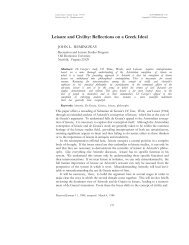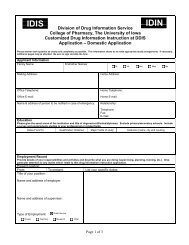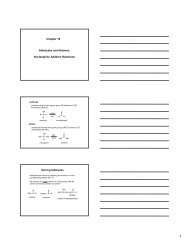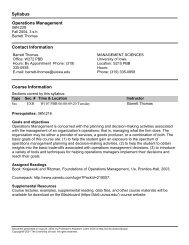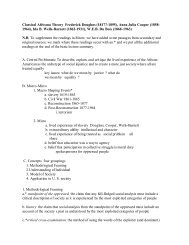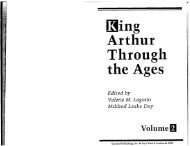Twenty-Five Years of Batson: An Introduction to ... - University of Iowa
Twenty-Five Years of Batson: An Introduction to ... - University of Iowa
Twenty-Five Years of Batson: An Introduction to ... - University of Iowa
You also want an ePaper? Increase the reach of your titles
YUMPU automatically turns print PDFs into web optimized ePapers that Google loves.
2012] TWENTY-FIVE YEARS OF BATSON 1407<br />
In Powers, a white defendant on trial for murder and attempted murder<br />
objected <strong>to</strong> the government’s use <strong>of</strong> six <strong>of</strong> its nine peremp<strong>to</strong>ry strikes <strong>to</strong><br />
remove black venirepersons. 110 The trial court overruled the objections, and<br />
he was convicted. 111 On appeal, seven Supreme Court Justices concluded<br />
“that a criminal defendant may object <strong>to</strong> race-based exclusions <strong>of</strong> jurors<br />
effected through peremp<strong>to</strong>ry challenges whether or not the defendant and<br />
the excluded juror share the same race.” 112<br />
<strong>Batson</strong> held that a defendant established a prima facie case by showing<br />
that the prosecu<strong>to</strong>r removed members <strong>of</strong> his own race. Powers eliminated this<br />
constraint, concluding that a showing that strikes were used <strong>to</strong> remove<br />
members <strong>of</strong> any race sufficed. <strong>Batson</strong> had expressed concern not only with<br />
the impacts <strong>of</strong> discrimina<strong>to</strong>ry challenges on defendants but also with their<br />
effects on jurors and the community. 113 Strikes <strong>of</strong> jurors <strong>of</strong> a different race<br />
did not deprive the accused <strong>of</strong> equal protection, 114 but did infringe upon the<br />
jurors’ equal protection rights and the community’s interest in legitimate<br />
jury selection procedures. Consequently, the Court found it necessary <strong>to</strong><br />
accord criminal defendants third-party standing <strong>to</strong> raise jurors’ rights—and<br />
<strong>to</strong> grant them relief for violations <strong>of</strong> those rights. 115 In Edmonson, a black<br />
construction worker sued a concrete company, claiming injuries from an<br />
employee’s negligent truck operation. 116 When the company peremp<strong>to</strong>rily<br />
removed two black jurors, the plaintiff raised a <strong>Batson</strong> objection. 117 The<br />
lower courts refused <strong>to</strong> apply <strong>Batson</strong> <strong>to</strong> private civil litigants. 118<br />
Six Supreme Court Justices disagreed, concluding that <strong>Batson</strong>’s<br />
principles and safeguards extend <strong>to</strong> peremp<strong>to</strong>ries exercised by private<br />
parties in civil proceedings. 119 The majority piggybacked on the two central<br />
premises in Powers—that jurors struck on account <strong>of</strong> race suffer equal<br />
protection violations and that a party injured by unconstitutional strikes has<br />
110. Powers, 499 U.S. at 403.<br />
111. Id.<br />
112. Id. at 402. Justice Scalia objected that the majority’s extension <strong>of</strong> <strong>Batson</strong> went beyond<br />
Strauder and other equal protection precedents that involved exclusion <strong>of</strong> jurors <strong>of</strong> the<br />
defendant’s race. Id. at 417–18, 420, 422 (Scalia, J., dissenting).<br />
113. See id. at 406 (majority opinion).<br />
114. See id. at 404 (noting that a defendant suffers an equal protection deprivation when<br />
“members <strong>of</strong> his or her race have been excluded” from the jury).<br />
115. See id. at 411–15. A defendant suffered “cognizable injury” when a juror was excluded<br />
on account <strong>of</strong> race. Id. at 411. According <strong>to</strong> the Powers majority, race could not serve as “a proxy<br />
for . . . bias or competence” and had no relationship <strong>to</strong> juror fitness. Id. at 410. Stereotypebased<br />
strikes violated equal protection even if “members <strong>of</strong> all races” were struck on the basis <strong>of</strong><br />
assumptions rooted solely in race, because “racial classifications” are impermissible and “do not<br />
become legitimate” because all races “suffer them” equally. Id.<br />
116. Edmonson v. Leesville Concrete Co., 500 U.S. 614, 616 (1991).<br />
117. Id. at 616–17.<br />
118. Id. at 617.<br />
119. Id. at 630.





